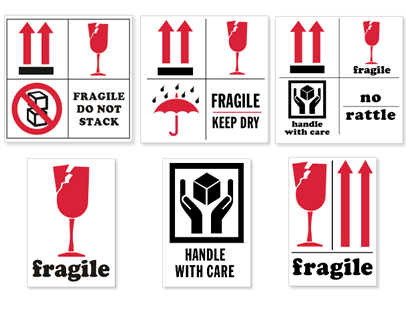Labeling bundled items can be an undeniably complex process. Large scale manufacturing or distribution item storage, retrieval, handling, bundling and dispatching require streamlined shipping solutions. Having the right shipping labels is often the key to smoothly processing picked items and satisfying distribution requirements
Knowing what the right design and construction is for your shipping label can ensure that plant and distribution center shipping lines work effectively and without stoppage while providing effective ata collection for shippers and recipients. Today’s hipping labels can be applied to almost any surface or packing material, including:
- Cardboard boxes or containers
- Plastic compartments (“clamshells”)
- Glass containers or vials
- Shrink wrapped bundles
The highest possible percent of shipping data scan-ability is critical to assuring accurate and timely delivery of items to clients. This where combining shipping label design with label materials begins to provide the highest scan contrast based on the printing capabilities of your printers. Simply put, not all blank, stock shipping labels work well with all types of printers. This exposes your business to breakdowns in accuracy and timely delivery of your shipments.
These three shipping label fundamentals will help you get the right shipping labels for your business:
- Crisp label printing enhances accurate and timely delivery.
Crisp images and contrast result in cleaner scans which translate to fewer mis-picks, fewer missed deliveries and fewer wrong deliveries. The best way to get the cleanest scans is to test various label materials with your printers and scanners until you find the right material. There are dozens of materials, some designed for laser printers and others designed for multiple types of thermal printers. Take the time to test and then choose the label material that provides the best scanability for your lines.
- Distribution lines flow smoother when labels don’t jam.
Label jams impact everything else in the pick-ship process. Label jams are typically caused by shipping labels that are the wrong shape, size and/or thickness. You can and should investigate multiple shipping label designs, including those that are specifically constructed for your unique business processes, printers and labelers. You should experiment with different thicknesses and materials of the label liner, the label face stock and the label adhesive. Get the combination of these label elements correct and you’ll have far fewer jams.
- More than a shipping label, it’s a packing list and RMA as well.
You can do more than just print pick and ship labels at one time. Look for shipping labels on sheets, that enable you to print the packing list and a return merchandise label as well on the same sheet. These types of label constructions save many companies significant amounts of time and money on their shipping lines.
Identify potential and real issues with your pick and ship processes and then look for label solutions that resolve your issues and potentially open up opportunities to save time and money. The solutions are out there waiting for you to explore them.







Recent Comments